Make Up For Ever Lavenders & Purples Artist Color Shadows Reviews, Photos, Swatches
ME912 Orchid
Make Up For Ever ME912 Orchid Artist Color Shadow ($17.00 for 0.08 oz.) is a vibrant, medium-dark magenta with cooler, violet pearl and a soft, metallic sheen. The consistency was denser, a bit stiff initially, but it became easier and easier to use after two uses. It had rich color payoff in a single layer that applied evenly to bare skin and blended out nicely without losing its intensity. The new formula is slightly brighter and cooler in tone but otherwise was quite similar (see side-by-side comparison). It wore well for 10 and a half hours on my lid and nine and a half hours on my cheeks.
As far as I can tell, there are still shades within the Artist Color Shadow range that aren’t listed as eye safe (in the U.S.), though this information appears in the form of a “face” symbol on the underside of the physical shadow (as opposed to an “eye” symbol). This same type of symbol system was used on their loose and liquid Star Lit products, and if they were appropriate for multiple areas, the label included multiple symbols (like an eye, face, and set of lips). This shade did not have an eye symbol on its label.
FURTHER READING: Formula Overview for details on general performance and characteristics (like scent).
Top Dupes
- Make Up For Ever ME912 Orchid (DC, $21.00) is warmer (95% similar).
- Ardency Inn Orchid (DC, $21.00) is darker (90% similar).
- Urban Decay Fishnet (DC, $19.00) is darker (90% similar).
- MAC Stars 'n' Rockets (P, $17.00) is lighter, more muted (90% similar).
- Lethal Cosmetics Enigma (P, $6.00) is more shimmery, lighter (90% similar).
- ColourPop Upload (LE, $4.50) is more shimmery (90% similar).
- Urban Decay Spitfire (LE, $19.00) is more shimmery, lighter (90% similar).
- MAC Femininity (LE, $32.50) is more shimmery, lighter (85% similar).
- ColourPop Starchild (P, $4.50) is more shimmery, lighter, cooler (85% similar).
- Anastasia Electro (P, $12.00) is more shimmery, lighter (85% similar).
Formula Overview
$17.00/0.08 oz. - $212.50 Per Ounce
The original Artist Shadow formula had a creamier, slightly softer, and thicker feel for finishes like Metallic, Iridescent, and Satin, while I felt the original Diamond finish was denser/thicker (heavier almost) and the Matte finish was more powdery but similar in softness and pigmentation (I did not find the original Mattes to be ultra pigmented across the board--semi-opaque to opaque, buildable, which you can see in my original swatches here). By and large, I found the formula to be easy to work with and did not have to spend a lot of time blending or fussing with the shades on the lid.
The new Matte formula has a smoother consistency that has more slip to the touch with less powderiness in the pan, but the pigmentation did seem slightly weaker on average compared to the original formula. The pigmentation of the new Matte formula was still semi-opaque to opaque and buildable but I felt like there were just more shades that were closer to semi-opaque than to opaque.
However, shades like M402 Mimosa showed improvement, as it used to be a Satin (see here) and not as easy to work with due to the denser texture. A lot of the shades were similar in color between the formulas, but there were a few that were not (M546 Dark Purple Taupe was a shade with more significant changes; the new version is warmer and lighter).
Overall, I did not have any issues applying most of the matte shades to the lid, blending them out, or building up coverage. They lasted between nine and ten hours on me, which was actually a bit longer (on average) compared to the original formula, where the mattes tended to wear between seven and eight hours on me (without primer).
The new Satin formula was the most different; it had weaker pigmentation, felt denser and drier with less give and creaminess. In practice, I did not feel like application was harder or noticeably different other than feeling like more of the shades required two layers for more opaque coverage, though some of the more neutral shades were fairly pigmented in a single layer. I also noticed that this particular finish seemed to be the most culled; there weren't that many shades in it, and I wonder if they did not sell well or something about the finish is harder to produce.
There were significant differences in color (and/or undertone) between shades in the new formula and old formula (with the same names) within this finish, too, where most were different rather than only a handful being different. The pigmentation of the new Satin formula was typically semi-opaque and buildable, while they applied evenly, blended out without much effort, and lasted between eight and ten hours (without primer).
The new Iridescent formula was the second most different and more comparable to the Satin finish in terms of overall feel and performance, just with larger shimmer/micro-sparkle. The new formula has a denser consistency (almost "drier" and with less slip) and didn't feel as cream-like, but the powder seemed to pickup better with most brushes and was more consistent in the actual finish--pearly with sparkle--whereas the original formula varied more heavily between pearly and metallic, sparkle and finer shimmer.
There were, however, more substantial color and undertone differences between old and new within this formula, like I saw with the Satin formula. Overall, I did not experience any significant issues applying most of the shades to the lid--they were semi-opaque to opaque, fairly buildable, blendable, and long-wearing (eight to ten hours).
The new Metallic formula was the most consistent between old and new for overall feel, performance, and color. There were, of course, a few shades that seemed lighter/darker, cooler/warmer compared to the previous versions, and all those notes will be made within the respective shade's review. I think the new Metallic finish has a more flattering look on the lid, as the consistency wasn't quite as thick, which should make it apply and appear smoother on the lid for more people.
There were several shades that seemed slightly deeper or less reflective, while others were as reflective as past versions. The majority of the shades of this finish were very pigmented with a moderately dense, lightly creamy texture that blended out well on the lid and wore between nine and ten hours on me.
The new Diamond finish was noticeably less dense/thick, particularly on the lid, which did make it easier to spread across a larger area and easier to pickup with more types of brushes. I was worried that there would be more fallout, but I haven't noticeable much fallout with the new Diamond shades over the eight to ten hours they last for.
Most of them had good pigmentation, though there were a few that were weaker (medium to semi-opaque coverage); a shade like D410 Gold Nugget was a weaker shade before and still is while D326 Lagoon Blue is significantly less pigmented in the new formula.
As I typically do with new eyeshadow formulas, I tested a few shades from each finish over various primers, as I like to see how new formulas interact with different types of primers and if there are any unexpected consequences of using primers (I felt that some of the more silicone-heavy Artist Shadows from before actually applied better without primer).
I didn't notice any ill effects of using primers like Smashbox 24-Hour, Marc Jacobs Coconut Eye Primer, Too Faced Shadow Insurance, or Urban Decay Primer Potion. They all seemed to just help with wear, and with some of the shades that felt drier or had weaker pigmentation, the use of primer seemed to improve initial coverage levels, too.
Browse all of our Make Up For Ever Artist Color Shadow swatches.
Ingredients

ME912 Orchid
PPermanent. $17.00.
D926 Blueberry
Make Up For Ever D926 Blueberry Artist Color Shadow ($17.00 for 0.08 oz.) is a dark purple with subtle, warm pink undertones and a sparkling, metallic sheen. It had good color coverage, though it took a second layer for true, opaque coverage. The eyeshadow felt smooth to the touch without any powderiness, but it did seem a little too firm or too thin, so it wasn’t quite as blendable as other shades in the range. The new version is much deeper and has less finer shimmer, so it wasn’t as reflective (but it still had the larger sparkles typically present in the Diamond finish shades), and the slightly drier, firmer texture made it feel less plush to the touch and took a bit of extra effort to blend but still was very blendable relative to most formulas on the market (in general) (see side-by-side comparison). It lasted for 10 hours on me and didn’t have any noticeable fallout.
FURTHER READING: Formula Overview for details on general performance and characteristics (like scent).
Top Dupes
- Melt Cosmetics Flaky (LE, ) is less shimmery, cooler (95% similar).
- Dior Lilas Mitzah (176) (P, $29.00) is less shimmery, darker (90% similar).
- Urban Decay Hex Remedy (LE, $19.00) is less shimmery, lighter (90% similar).
- Sydney Grace Pandora (P, $5.00) is more shimmery, lighter (90% similar).
- Tom Ford Beauty Violet Argente #4 (Eye Color) (LE, ) is less shimmery, darker (90% similar).
- Sugarpill Hysteric (P, $13.00) is more shimmery, lighter (90% similar).
- Make Up For Ever D926 Blueberry (DC, $21.00) is more shimmery, lighter (85% similar).
- Huda Beauty Electric #2 (PiP, ) is more shimmery, lighter (85% similar).
- Maybelline Potent Purple (P, $6.99) is less shimmery (85% similar).
- Urban Decay Vice (DC, $19.00) is less shimmery, darker (85% similar).
Formula Overview
$17.00/0.08 oz. - $212.50 Per Ounce
The original Artist Shadow formula had a creamier, slightly softer, and thicker feel for finishes like Metallic, Iridescent, and Satin, while I felt the original Diamond finish was denser/thicker (heavier almost) and the Matte finish was more powdery but similar in softness and pigmentation (I did not find the original Mattes to be ultra pigmented across the board--semi-opaque to opaque, buildable, which you can see in my original swatches here). By and large, I found the formula to be easy to work with and did not have to spend a lot of time blending or fussing with the shades on the lid.
The new Matte formula has a smoother consistency that has more slip to the touch with less powderiness in the pan, but the pigmentation did seem slightly weaker on average compared to the original formula. The pigmentation of the new Matte formula was still semi-opaque to opaque and buildable but I felt like there were just more shades that were closer to semi-opaque than to opaque.
However, shades like M402 Mimosa showed improvement, as it used to be a Satin (see here) and not as easy to work with due to the denser texture. A lot of the shades were similar in color between the formulas, but there were a few that were not (M546 Dark Purple Taupe was a shade with more significant changes; the new version is warmer and lighter).
Overall, I did not have any issues applying most of the matte shades to the lid, blending them out, or building up coverage. They lasted between nine and ten hours on me, which was actually a bit longer (on average) compared to the original formula, where the mattes tended to wear between seven and eight hours on me (without primer).
The new Satin formula was the most different; it had weaker pigmentation, felt denser and drier with less give and creaminess. In practice, I did not feel like application was harder or noticeably different other than feeling like more of the shades required two layers for more opaque coverage, though some of the more neutral shades were fairly pigmented in a single layer. I also noticed that this particular finish seemed to be the most culled; there weren't that many shades in it, and I wonder if they did not sell well or something about the finish is harder to produce.
There were significant differences in color (and/or undertone) between shades in the new formula and old formula (with the same names) within this finish, too, where most were different rather than only a handful being different. The pigmentation of the new Satin formula was typically semi-opaque and buildable, while they applied evenly, blended out without much effort, and lasted between eight and ten hours (without primer).
The new Iridescent formula was the second most different and more comparable to the Satin finish in terms of overall feel and performance, just with larger shimmer/micro-sparkle. The new formula has a denser consistency (almost "drier" and with less slip) and didn't feel as cream-like, but the powder seemed to pickup better with most brushes and was more consistent in the actual finish--pearly with sparkle--whereas the original formula varied more heavily between pearly and metallic, sparkle and finer shimmer.
There were, however, more substantial color and undertone differences between old and new within this formula, like I saw with the Satin formula. Overall, I did not experience any significant issues applying most of the shades to the lid--they were semi-opaque to opaque, fairly buildable, blendable, and long-wearing (eight to ten hours).
The new Metallic formula was the most consistent between old and new for overall feel, performance, and color. There were, of course, a few shades that seemed lighter/darker, cooler/warmer compared to the previous versions, and all those notes will be made within the respective shade's review. I think the new Metallic finish has a more flattering look on the lid, as the consistency wasn't quite as thick, which should make it apply and appear smoother on the lid for more people.
There were several shades that seemed slightly deeper or less reflective, while others were as reflective as past versions. The majority of the shades of this finish were very pigmented with a moderately dense, lightly creamy texture that blended out well on the lid and wore between nine and ten hours on me.
The new Diamond finish was noticeably less dense/thick, particularly on the lid, which did make it easier to spread across a larger area and easier to pickup with more types of brushes. I was worried that there would be more fallout, but I haven't noticeable much fallout with the new Diamond shades over the eight to ten hours they last for.
Most of them had good pigmentation, though there were a few that were weaker (medium to semi-opaque coverage); a shade like D410 Gold Nugget was a weaker shade before and still is while D326 Lagoon Blue is significantly less pigmented in the new formula.
As I typically do with new eyeshadow formulas, I tested a few shades from each finish over various primers, as I like to see how new formulas interact with different types of primers and if there are any unexpected consequences of using primers (I felt that some of the more silicone-heavy Artist Shadows from before actually applied better without primer).
I didn't notice any ill effects of using primers like Smashbox 24-Hour, Marc Jacobs Coconut Eye Primer, Too Faced Shadow Insurance, or Urban Decay Primer Potion. They all seemed to just help with wear, and with some of the shades that felt drier or had weaker pigmentation, the use of primer seemed to improve initial coverage levels, too.
Browse all of our Make Up For Ever Artist Color Shadow swatches.
Ingredients

D926 Blueberry
DCDiscontinued. $17.00.
ME930 Black Purple
Make Up For Ever ME930 Black Purple Artist Color Shadow ($17.00 for 0.08 oz.) is a deep purple with subtle, warm brown undertones and a pearly sheen. It was substantially different in color and finish compared to the previous formulation; the new version is much deeper and a lot less metallic (and likely, the reduced shimmer meant it reflected less light and would be darker) (see side-by-side comparison). In terms of performance, I found little difference in practice–they both were pigmented, easy to work with, and long-wearing–but by feel, the new formula wasn’t as creamy or as thick/dense on the lid (which may be kinder on more textured skin). The consistency of the new shade was smooth, slightly firm and moderately dense but never stiff or difficult to pickup with a brush. It applied evenly to the lid and blended with minimal effort. This shade wore well for 10 and a half hours on me.
FURTHER READING: Formula Overview for details on general performance and characteristics (like scent).
Top Dupes
- Estee Lauder Cyber Lilac (LE, $24.00) is more shimmery, lighter (95% similar).
- Marc Jacobs Beauty How You Want (PiP, ) is lighter (95% similar).
- Tarte Illusion (LE, ) is lighter (95% similar).
- MAC Round Midnight (LE, $20.00) is warmer (90% similar).
- Smashbox Stormy (P, ) is more shimmery, lighter, cooler (90% similar).
- Danessa Myricks Truth (P, $18.00) is cooler (90% similar).
- Fyrinnae Alchemist's Curse (P, $6.80) is lighter (90% similar).
- bareMinerals Yoga (LE, $14.00) is warmer (90% similar).
- Guerlain Electric Look #9 (LE, ) is less shimmery, lighter (90% similar).
- Bobbi Brown Black Violet (P, $24.00) is lighter, warmer (90% similar).
Formula Overview
$17.00/0.08 oz. - $212.50 Per Ounce
The original Artist Shadow formula had a creamier, slightly softer, and thicker feel for finishes like Metallic, Iridescent, and Satin, while I felt the original Diamond finish was denser/thicker (heavier almost) and the Matte finish was more powdery but similar in softness and pigmentation (I did not find the original Mattes to be ultra pigmented across the board--semi-opaque to opaque, buildable, which you can see in my original swatches here). By and large, I found the formula to be easy to work with and did not have to spend a lot of time blending or fussing with the shades on the lid.
The new Matte formula has a smoother consistency that has more slip to the touch with less powderiness in the pan, but the pigmentation did seem slightly weaker on average compared to the original formula. The pigmentation of the new Matte formula was still semi-opaque to opaque and buildable but I felt like there were just more shades that were closer to semi-opaque than to opaque.
However, shades like M402 Mimosa showed improvement, as it used to be a Satin (see here) and not as easy to work with due to the denser texture. A lot of the shades were similar in color between the formulas, but there were a few that were not (M546 Dark Purple Taupe was a shade with more significant changes; the new version is warmer and lighter).
Overall, I did not have any issues applying most of the matte shades to the lid, blending them out, or building up coverage. They lasted between nine and ten hours on me, which was actually a bit longer (on average) compared to the original formula, where the mattes tended to wear between seven and eight hours on me (without primer).
The new Satin formula was the most different; it had weaker pigmentation, felt denser and drier with less give and creaminess. In practice, I did not feel like application was harder or noticeably different other than feeling like more of the shades required two layers for more opaque coverage, though some of the more neutral shades were fairly pigmented in a single layer. I also noticed that this particular finish seemed to be the most culled; there weren't that many shades in it, and I wonder if they did not sell well or something about the finish is harder to produce.
There were significant differences in color (and/or undertone) between shades in the new formula and old formula (with the same names) within this finish, too, where most were different rather than only a handful being different. The pigmentation of the new Satin formula was typically semi-opaque and buildable, while they applied evenly, blended out without much effort, and lasted between eight and ten hours (without primer).
The new Iridescent formula was the second most different and more comparable to the Satin finish in terms of overall feel and performance, just with larger shimmer/micro-sparkle. The new formula has a denser consistency (almost "drier" and with less slip) and didn't feel as cream-like, but the powder seemed to pickup better with most brushes and was more consistent in the actual finish--pearly with sparkle--whereas the original formula varied more heavily between pearly and metallic, sparkle and finer shimmer.
There were, however, more substantial color and undertone differences between old and new within this formula, like I saw with the Satin formula. Overall, I did not experience any significant issues applying most of the shades to the lid--they were semi-opaque to opaque, fairly buildable, blendable, and long-wearing (eight to ten hours).
The new Metallic formula was the most consistent between old and new for overall feel, performance, and color. There were, of course, a few shades that seemed lighter/darker, cooler/warmer compared to the previous versions, and all those notes will be made within the respective shade's review. I think the new Metallic finish has a more flattering look on the lid, as the consistency wasn't quite as thick, which should make it apply and appear smoother on the lid for more people.
There were several shades that seemed slightly deeper or less reflective, while others were as reflective as past versions. The majority of the shades of this finish were very pigmented with a moderately dense, lightly creamy texture that blended out well on the lid and wore between nine and ten hours on me.
The new Diamond finish was noticeably less dense/thick, particularly on the lid, which did make it easier to spread across a larger area and easier to pickup with more types of brushes. I was worried that there would be more fallout, but I haven't noticeable much fallout with the new Diamond shades over the eight to ten hours they last for.
Most of them had good pigmentation, though there were a few that were weaker (medium to semi-opaque coverage); a shade like D410 Gold Nugget was a weaker shade before and still is while D326 Lagoon Blue is significantly less pigmented in the new formula.
As I typically do with new eyeshadow formulas, I tested a few shades from each finish over various primers, as I like to see how new formulas interact with different types of primers and if there are any unexpected consequences of using primers (I felt that some of the more silicone-heavy Artist Shadows from before actually applied better without primer).
I didn't notice any ill effects of using primers like Smashbox 24-Hour, Marc Jacobs Coconut Eye Primer, Too Faced Shadow Insurance, or Urban Decay Primer Potion. They all seemed to just help with wear, and with some of the shades that felt drier or had weaker pigmentation, the use of primer seemed to improve initial coverage levels, too.
Browse all of our Make Up For Ever Artist Color Shadow swatches.
Ingredients

ME930 Black Purple
PPermanent. $17.00.
I918 Lavender
Make Up For Ever I918 Lavender Artist Color Shadow ($17.00 for 0.08 oz.) is a light-medium lavender with subtle, warm undertones and a pearly sheen. The pigmentation was nearly opaque in a single layer. The texture was smooth to the touch with a moderately dense texture that was firmer so it did not have any excess product that kicked up in the pan when used (nor fallout when applied), but it was still easy to blend and pickup with my brushes. The new version is several shades darker and warmer (see side-by-side comparison). On me, it stayed on well for nine and a half hours on both lips and eyes.
As far as I can tell, there are still shades within the Artist Color Shadow range that aren’t listed as eye safe (in the U.S.), though this information appears in the form of a “face” symbol on the underside of the physical shadow (as opposed to an “eye” symbol). This same type of symbol system was used on their loose and liquid Star Lit products, and if they were appropriate for multiple areas, the label included multiple symbols (like an eye, face, and set of lips). This shade did not have an eye symbol on its label.
FURTHER READING: Formula Overview for details on general performance and characteristics (like scent).
Top Dupes
- KVD Beauty Violator (LE, ) is lighter (90% similar).
- KVD Beauty Arcadia (LE, ) is darker, cooler (90% similar).
- elf Supernova (P, $6.00) is more shimmery, darker (90% similar).
- Buxom La-La-Lavish (P, $12.00) is more shimmery, warmer (90% similar).
- Zoeva Spirits Held Desire (LE, ) is lighter, warmer (85% similar).
- Makeup Geek Hot Pants (DC, $6.00) is darker, warmer (85% similar).
- LORAC Smoothie (LE, $19.00) is less shimmery, warmer (85% similar).
- Make Up For Ever #54 (LE, $23.00) is darker (85% similar).
- Melt Cosmetics Uranium (PiP, ) is darker, cooler (85% similar).
- Urban Decay Betrayal (LE, $19.00) is darker (85% similar).
Formula Overview
$17.00/0.08 oz. - $212.50 Per Ounce
The original Artist Shadow formula had a creamier, slightly softer, and thicker feel for finishes like Metallic, Iridescent, and Satin, while I felt the original Diamond finish was denser/thicker (heavier almost) and the Matte finish was more powdery but similar in softness and pigmentation (I did not find the original Mattes to be ultra pigmented across the board--semi-opaque to opaque, buildable, which you can see in my original swatches here). By and large, I found the formula to be easy to work with and did not have to spend a lot of time blending or fussing with the shades on the lid.
The new Matte formula has a smoother consistency that has more slip to the touch with less powderiness in the pan, but the pigmentation did seem slightly weaker on average compared to the original formula. The pigmentation of the new Matte formula was still semi-opaque to opaque and buildable but I felt like there were just more shades that were closer to semi-opaque than to opaque.
However, shades like M402 Mimosa showed improvement, as it used to be a Satin (see here) and not as easy to work with due to the denser texture. A lot of the shades were similar in color between the formulas, but there were a few that were not (M546 Dark Purple Taupe was a shade with more significant changes; the new version is warmer and lighter).
Overall, I did not have any issues applying most of the matte shades to the lid, blending them out, or building up coverage. They lasted between nine and ten hours on me, which was actually a bit longer (on average) compared to the original formula, where the mattes tended to wear between seven and eight hours on me (without primer).
The new Satin formula was the most different; it had weaker pigmentation, felt denser and drier with less give and creaminess. In practice, I did not feel like application was harder or noticeably different other than feeling like more of the shades required two layers for more opaque coverage, though some of the more neutral shades were fairly pigmented in a single layer. I also noticed that this particular finish seemed to be the most culled; there weren't that many shades in it, and I wonder if they did not sell well or something about the finish is harder to produce.
There were significant differences in color (and/or undertone) between shades in the new formula and old formula (with the same names) within this finish, too, where most were different rather than only a handful being different. The pigmentation of the new Satin formula was typically semi-opaque and buildable, while they applied evenly, blended out without much effort, and lasted between eight and ten hours (without primer).
The new Iridescent formula was the second most different and more comparable to the Satin finish in terms of overall feel and performance, just with larger shimmer/micro-sparkle. The new formula has a denser consistency (almost "drier" and with less slip) and didn't feel as cream-like, but the powder seemed to pickup better with most brushes and was more consistent in the actual finish--pearly with sparkle--whereas the original formula varied more heavily between pearly and metallic, sparkle and finer shimmer.
There were, however, more substantial color and undertone differences between old and new within this formula, like I saw with the Satin formula. Overall, I did not experience any significant issues applying most of the shades to the lid--they were semi-opaque to opaque, fairly buildable, blendable, and long-wearing (eight to ten hours).
The new Metallic formula was the most consistent between old and new for overall feel, performance, and color. There were, of course, a few shades that seemed lighter/darker, cooler/warmer compared to the previous versions, and all those notes will be made within the respective shade's review. I think the new Metallic finish has a more flattering look on the lid, as the consistency wasn't quite as thick, which should make it apply and appear smoother on the lid for more people.
There were several shades that seemed slightly deeper or less reflective, while others were as reflective as past versions. The majority of the shades of this finish were very pigmented with a moderately dense, lightly creamy texture that blended out well on the lid and wore between nine and ten hours on me.
The new Diamond finish was noticeably less dense/thick, particularly on the lid, which did make it easier to spread across a larger area and easier to pickup with more types of brushes. I was worried that there would be more fallout, but I haven't noticeable much fallout with the new Diamond shades over the eight to ten hours they last for.
Most of them had good pigmentation, though there were a few that were weaker (medium to semi-opaque coverage); a shade like D410 Gold Nugget was a weaker shade before and still is while D326 Lagoon Blue is significantly less pigmented in the new formula.
As I typically do with new eyeshadow formulas, I tested a few shades from each finish over various primers, as I like to see how new formulas interact with different types of primers and if there are any unexpected consequences of using primers (I felt that some of the more silicone-heavy Artist Shadows from before actually applied better without primer).
I didn't notice any ill effects of using primers like Smashbox 24-Hour, Marc Jacobs Coconut Eye Primer, Too Faced Shadow Insurance, or Urban Decay Primer Potion. They all seemed to just help with wear, and with some of the shades that felt drier or had weaker pigmentation, the use of primer seemed to improve initial coverage levels, too.
Browse all of our Make Up For Ever Artist Color Shadow swatches.
Ingredients

I918 Lavender
PPermanent. $17.00.
M924 Purple
Make Up For Ever M924 Purple Artist Color Shadow ($17.00 for 0.08 oz.) is a bright, medium purple with subtle, cool undertones and a matte finish. The pigmentation semi-opaque but buildable, though the texture was drier and somewhat dense, so it did not diffuse or blend out as well as I would have liked. It was the type of shade that worked well packed onto the lid with a flat, shading brush or blended out with a clean brush or a lighter or more shimmery shade. The new shade is quite different from the previous shade, particularly since the brand switched the finish from Satin to Matte; the new shsade is deeper and much cooler in tone, along with the finish being matte (see side-by-side comparison). The color wore well for 10 hours on my lids and nine and a half hours on my cheeks.
As far as I can tell, there are still shades within the Artist Color Shadow range that aren’t listed as eye safe (in the U.S.), though this information appears in the form of a “face” symbol on the underside of the physical shadow (as opposed to an “eye” symbol). This same type of symbol system was used on their loose and liquid Star Lit products, and if they were appropriate for multiple areas, the label included multiple symbols (like an eye, face, and set of lips). This shade did not have an eye symbol on its label.
FURTHER READING: Formula Overview for details on general performance and characteristics (like scent).
Top Dupes
- Pat McGrath Violet Vixen (LE, $25.00) is more shimmery, warmer (95% similar).
- ColourPop Iffy (PiP, $4.50) is lighter, warmer (90% similar).
- Lethal Cosmetics Foxglove (P, $6.50) is lighter, cooler (90% similar).
- Marc Jacobs Beauty Outrageously (PiP, ) is lighter (90% similar).
- ColourPop Majestic (LE, $4.50) is lighter, warmer (90% similar).
- Give Me Glow Toxic (P, $7.00) is darker, warmer (90% similar).
- ColourPop Liaison (LE, $5.00) is lighter, more muted (90% similar).
- ColourPop Madison (PiP, $4.50) is lighter (90% similar).
- MAC Violet Blend #2 (LE, ) is more muted, warmer (85% similar).
- Give Me Glow Grapeness (P, $7.00) is darker, cooler (85% similar).
Formula Overview
$17.00/0.08 oz. - $212.50 Per Ounce
The original Artist Shadow formula had a creamier, slightly softer, and thicker feel for finishes like Metallic, Iridescent, and Satin, while I felt the original Diamond finish was denser/thicker (heavier almost) and the Matte finish was more powdery but similar in softness and pigmentation (I did not find the original Mattes to be ultra pigmented across the board--semi-opaque to opaque, buildable, which you can see in my original swatches here). By and large, I found the formula to be easy to work with and did not have to spend a lot of time blending or fussing with the shades on the lid.
The new Matte formula has a smoother consistency that has more slip to the touch with less powderiness in the pan, but the pigmentation did seem slightly weaker on average compared to the original formula. The pigmentation of the new Matte formula was still semi-opaque to opaque and buildable but I felt like there were just more shades that were closer to semi-opaque than to opaque.
However, shades like M402 Mimosa showed improvement, as it used to be a Satin (see here) and not as easy to work with due to the denser texture. A lot of the shades were similar in color between the formulas, but there were a few that were not (M546 Dark Purple Taupe was a shade with more significant changes; the new version is warmer and lighter).
Overall, I did not have any issues applying most of the matte shades to the lid, blending them out, or building up coverage. They lasted between nine and ten hours on me, which was actually a bit longer (on average) compared to the original formula, where the mattes tended to wear between seven and eight hours on me (without primer).
The new Satin formula was the most different; it had weaker pigmentation, felt denser and drier with less give and creaminess. In practice, I did not feel like application was harder or noticeably different other than feeling like more of the shades required two layers for more opaque coverage, though some of the more neutral shades were fairly pigmented in a single layer. I also noticed that this particular finish seemed to be the most culled; there weren't that many shades in it, and I wonder if they did not sell well or something about the finish is harder to produce.
There were significant differences in color (and/or undertone) between shades in the new formula and old formula (with the same names) within this finish, too, where most were different rather than only a handful being different. The pigmentation of the new Satin formula was typically semi-opaque and buildable, while they applied evenly, blended out without much effort, and lasted between eight and ten hours (without primer).
The new Iridescent formula was the second most different and more comparable to the Satin finish in terms of overall feel and performance, just with larger shimmer/micro-sparkle. The new formula has a denser consistency (almost "drier" and with less slip) and didn't feel as cream-like, but the powder seemed to pickup better with most brushes and was more consistent in the actual finish--pearly with sparkle--whereas the original formula varied more heavily between pearly and metallic, sparkle and finer shimmer.
There were, however, more substantial color and undertone differences between old and new within this formula, like I saw with the Satin formula. Overall, I did not experience any significant issues applying most of the shades to the lid--they were semi-opaque to opaque, fairly buildable, blendable, and long-wearing (eight to ten hours).
The new Metallic formula was the most consistent between old and new for overall feel, performance, and color. There were, of course, a few shades that seemed lighter/darker, cooler/warmer compared to the previous versions, and all those notes will be made within the respective shade's review. I think the new Metallic finish has a more flattering look on the lid, as the consistency wasn't quite as thick, which should make it apply and appear smoother on the lid for more people.
There were several shades that seemed slightly deeper or less reflective, while others were as reflective as past versions. The majority of the shades of this finish were very pigmented with a moderately dense, lightly creamy texture that blended out well on the lid and wore between nine and ten hours on me.
The new Diamond finish was noticeably less dense/thick, particularly on the lid, which did make it easier to spread across a larger area and easier to pickup with more types of brushes. I was worried that there would be more fallout, but I haven't noticeable much fallout with the new Diamond shades over the eight to ten hours they last for.
Most of them had good pigmentation, though there were a few that were weaker (medium to semi-opaque coverage); a shade like D410 Gold Nugget was a weaker shade before and still is while D326 Lagoon Blue is significantly less pigmented in the new formula.
As I typically do with new eyeshadow formulas, I tested a few shades from each finish over various primers, as I like to see how new formulas interact with different types of primers and if there are any unexpected consequences of using primers (I felt that some of the more silicone-heavy Artist Shadows from before actually applied better without primer).
I didn't notice any ill effects of using primers like Smashbox 24-Hour, Marc Jacobs Coconut Eye Primer, Too Faced Shadow Insurance, or Urban Decay Primer Potion. They all seemed to just help with wear, and with some of the shades that felt drier or had weaker pigmentation, the use of primer seemed to improve initial coverage levels, too.
Browse all of our Make Up For Ever Artist Color Shadow swatches.
Ingredients

M924 Purple
PPermanent. $17.00.
I528 Pearl
Make Up For Ever I528 Pearl Artist Color Shadow ($17.00 for 0.08 oz.) is a very light beige with warm, vanilla undertones and a subtle, pinkish sheen. It had good color coverage that applied evenly to bare skin and blended out nicely. The texture was smooth to the touch, dense but not too firm or too stiff in the pan, and easy to work with overall. The new shade had a much less shimmery finish–it appeared more muted and subdued as a result with a somewhat denser consistency overall (see side-by-side comparison). The color wore well for almost 10 hours on me.
FURTHER READING: Formula Overview for details on general performance and characteristics (like scent).
Top Dupes
- ColourPop Bluebell (LE, $4.50) is more shimmery, warmer (95% similar).
- NARS Mahe #3 (PiP, $19.00) is more shimmery (95% similar).
- LORAC Vanilla (LE, $19.00) is more shimmery (95% similar).
- Urban Decay Virgin (DC, $19.00) is darker (95% similar).
- LORAC Shiver Me (LE, $19.00) is darker (95% similar).
- MAC Dazzlelight (P, $17.00) is more shimmery (95% similar).
- Pretty Vulgar Pillow Fight (PiP, ) is darker (95% similar).
- NABLA Cosmetics Atom (P, $8.00) is less shimmery (95% similar).
- ColourPop Onai (LE, $6.00) is less shimmery, warmer (95% similar).
- Tarte Joy to the Pearl (LE, ) is more shimmery (95% similar).
Formula Overview
$17.00/0.08 oz. - $212.50 Per Ounce
The original Artist Shadow formula had a creamier, slightly softer, and thicker feel for finishes like Metallic, Iridescent, and Satin, while I felt the original Diamond finish was denser/thicker (heavier almost) and the Matte finish was more powdery but similar in softness and pigmentation (I did not find the original Mattes to be ultra pigmented across the board--semi-opaque to opaque, buildable, which you can see in my original swatches here). By and large, I found the formula to be easy to work with and did not have to spend a lot of time blending or fussing with the shades on the lid.
The new Matte formula has a smoother consistency that has more slip to the touch with less powderiness in the pan, but the pigmentation did seem slightly weaker on average compared to the original formula. The pigmentation of the new Matte formula was still semi-opaque to opaque and buildable but I felt like there were just more shades that were closer to semi-opaque than to opaque.
However, shades like M402 Mimosa showed improvement, as it used to be a Satin (see here) and not as easy to work with due to the denser texture. A lot of the shades were similar in color between the formulas, but there were a few that were not (M546 Dark Purple Taupe was a shade with more significant changes; the new version is warmer and lighter).
Overall, I did not have any issues applying most of the matte shades to the lid, blending them out, or building up coverage. They lasted between nine and ten hours on me, which was actually a bit longer (on average) compared to the original formula, where the mattes tended to wear between seven and eight hours on me (without primer).
The new Satin formula was the most different; it had weaker pigmentation, felt denser and drier with less give and creaminess. In practice, I did not feel like application was harder or noticeably different other than feeling like more of the shades required two layers for more opaque coverage, though some of the more neutral shades were fairly pigmented in a single layer. I also noticed that this particular finish seemed to be the most culled; there weren't that many shades in it, and I wonder if they did not sell well or something about the finish is harder to produce.
There were significant differences in color (and/or undertone) between shades in the new formula and old formula (with the same names) within this finish, too, where most were different rather than only a handful being different. The pigmentation of the new Satin formula was typically semi-opaque and buildable, while they applied evenly, blended out without much effort, and lasted between eight and ten hours (without primer).
The new Iridescent formula was the second most different and more comparable to the Satin finish in terms of overall feel and performance, just with larger shimmer/micro-sparkle. The new formula has a denser consistency (almost "drier" and with less slip) and didn't feel as cream-like, but the powder seemed to pickup better with most brushes and was more consistent in the actual finish--pearly with sparkle--whereas the original formula varied more heavily between pearly and metallic, sparkle and finer shimmer.
There were, however, more substantial color and undertone differences between old and new within this formula, like I saw with the Satin formula. Overall, I did not experience any significant issues applying most of the shades to the lid--they were semi-opaque to opaque, fairly buildable, blendable, and long-wearing (eight to ten hours).
The new Metallic formula was the most consistent between old and new for overall feel, performance, and color. There were, of course, a few shades that seemed lighter/darker, cooler/warmer compared to the previous versions, and all those notes will be made within the respective shade's review. I think the new Metallic finish has a more flattering look on the lid, as the consistency wasn't quite as thick, which should make it apply and appear smoother on the lid for more people.
There were several shades that seemed slightly deeper or less reflective, while others were as reflective as past versions. The majority of the shades of this finish were very pigmented with a moderately dense, lightly creamy texture that blended out well on the lid and wore between nine and ten hours on me.
The new Diamond finish was noticeably less dense/thick, particularly on the lid, which did make it easier to spread across a larger area and easier to pickup with more types of brushes. I was worried that there would be more fallout, but I haven't noticeable much fallout with the new Diamond shades over the eight to ten hours they last for.
Most of them had good pigmentation, though there were a few that were weaker (medium to semi-opaque coverage); a shade like D410 Gold Nugget was a weaker shade before and still is while D326 Lagoon Blue is significantly less pigmented in the new formula.
As I typically do with new eyeshadow formulas, I tested a few shades from each finish over various primers, as I like to see how new formulas interact with different types of primers and if there are any unexpected consequences of using primers (I felt that some of the more silicone-heavy Artist Shadows from before actually applied better without primer).
I didn't notice any ill effects of using primers like Smashbox 24-Hour, Marc Jacobs Coconut Eye Primer, Too Faced Shadow Insurance, or Urban Decay Primer Potion. They all seemed to just help with wear, and with some of the shades that felt drier or had weaker pigmentation, the use of primer seemed to improve initial coverage levels, too.
Browse all of our Make Up For Ever Artist Color Shadow swatches.
Ingredients



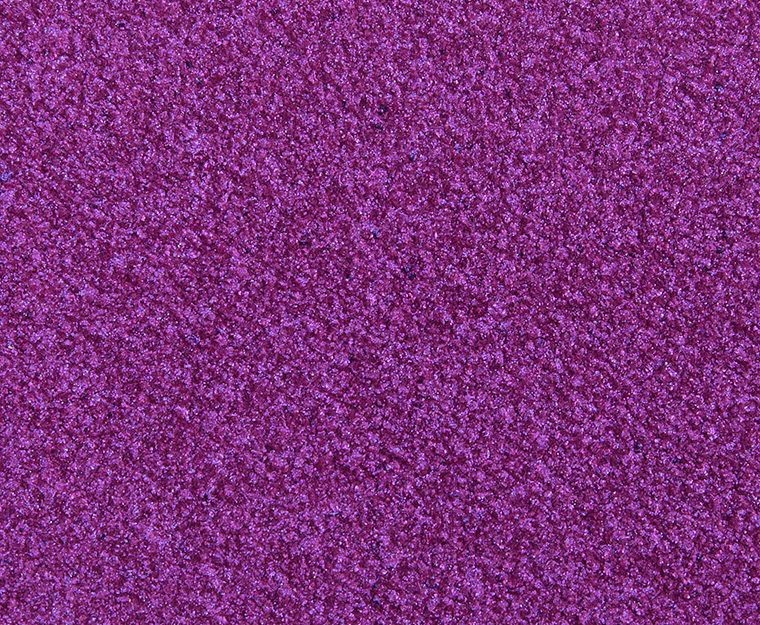

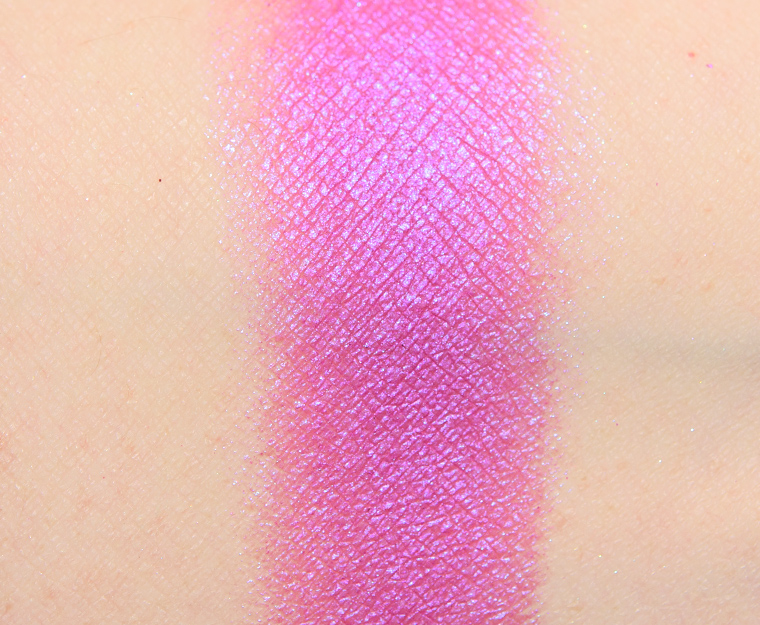

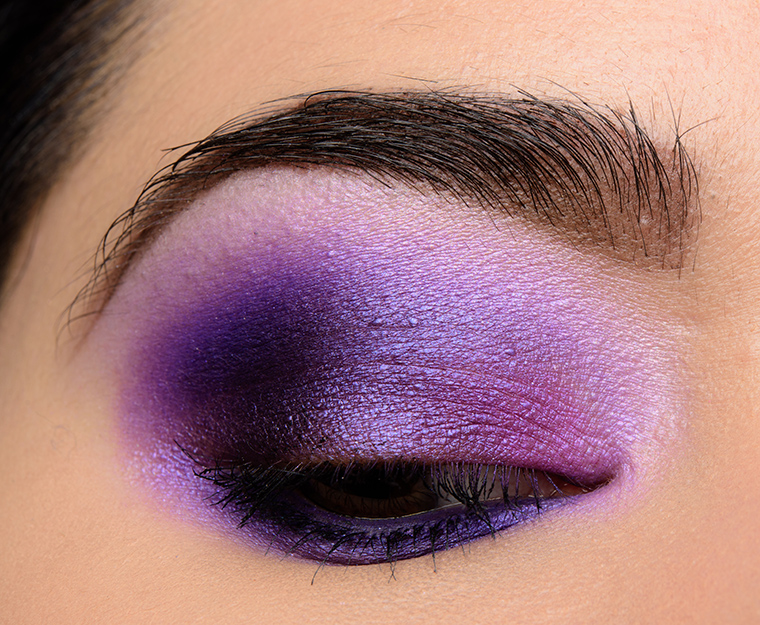









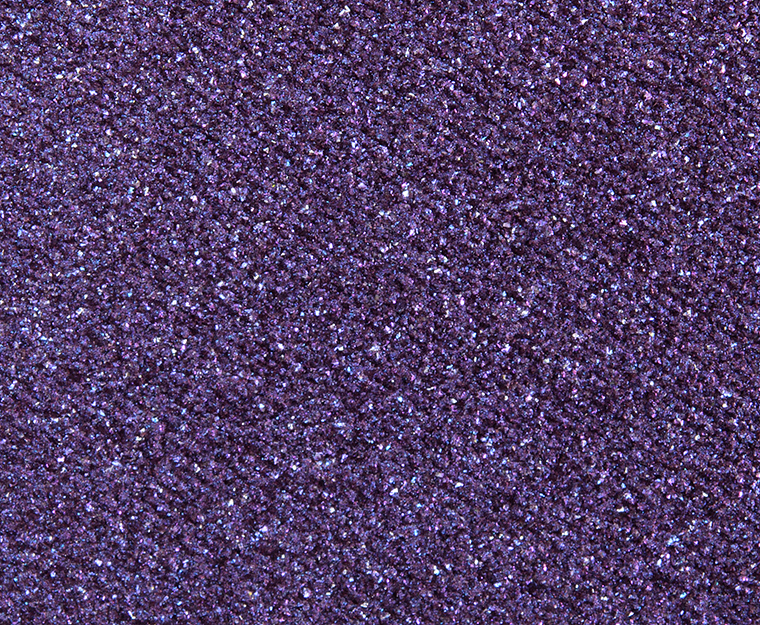










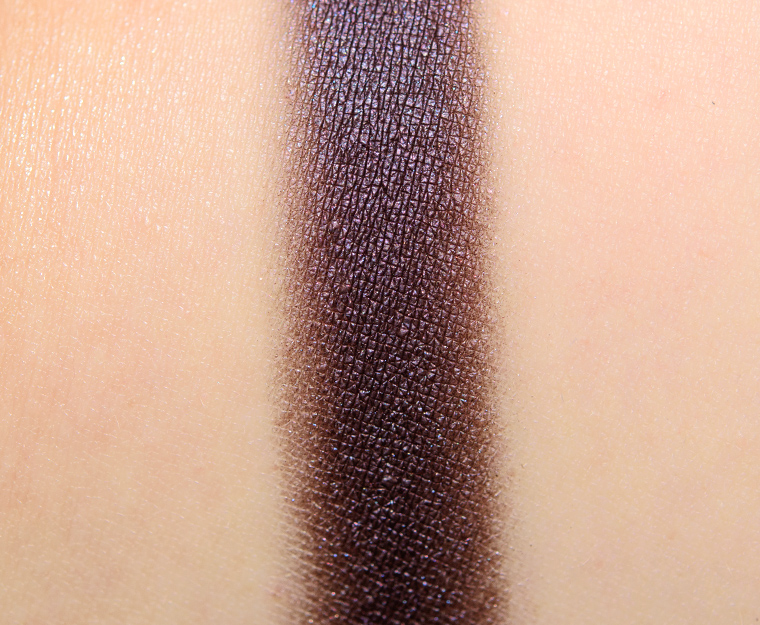






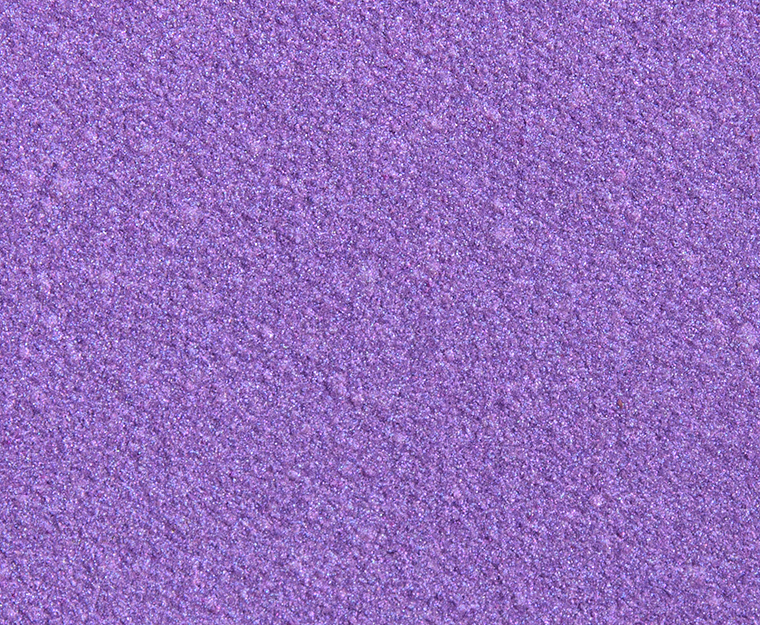

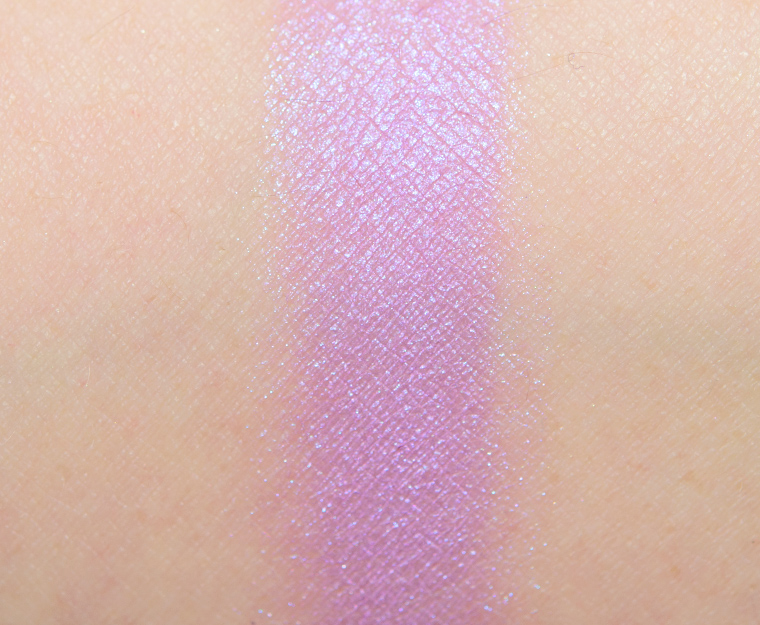







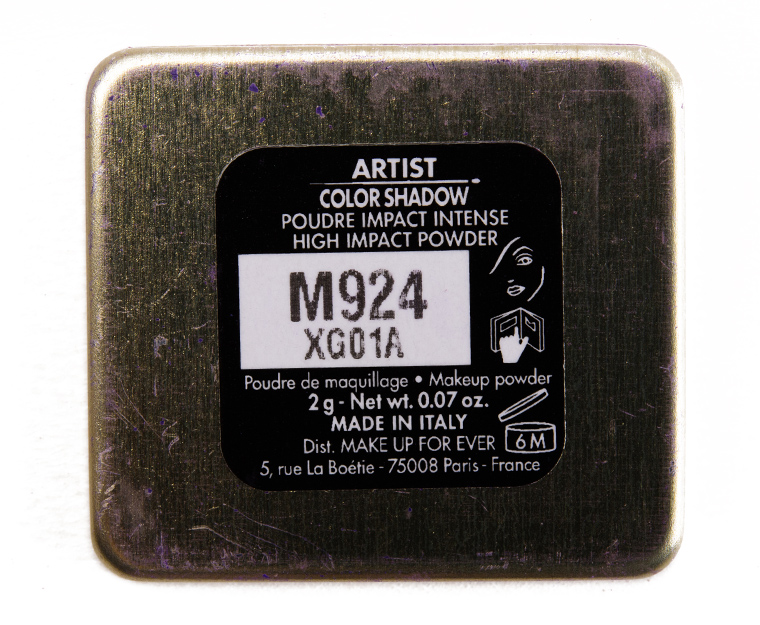
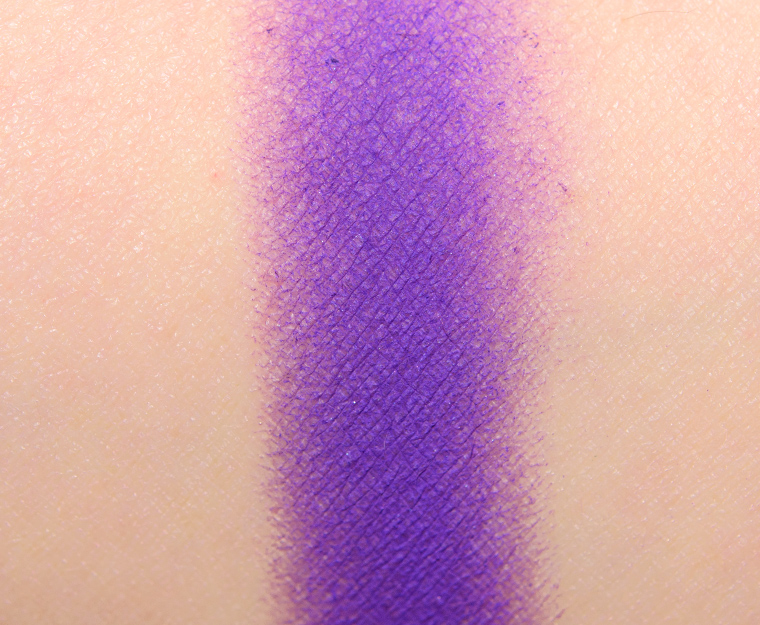






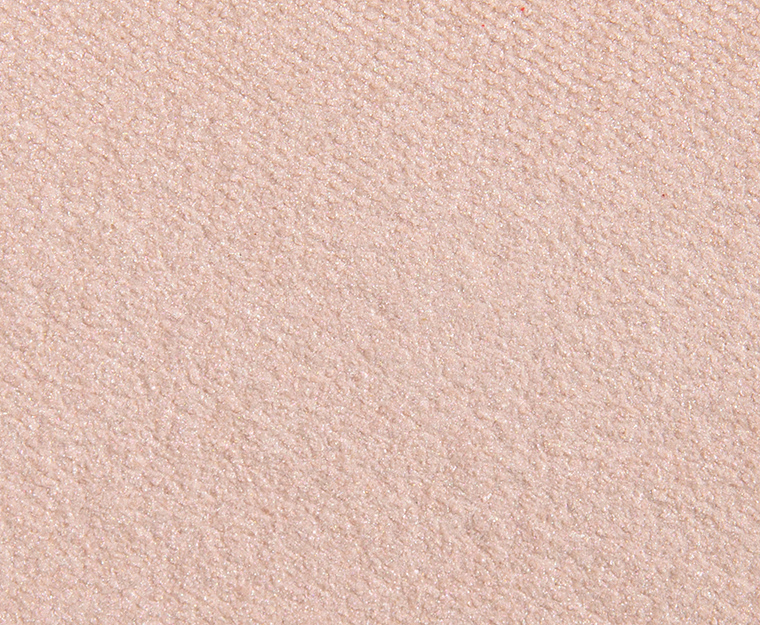
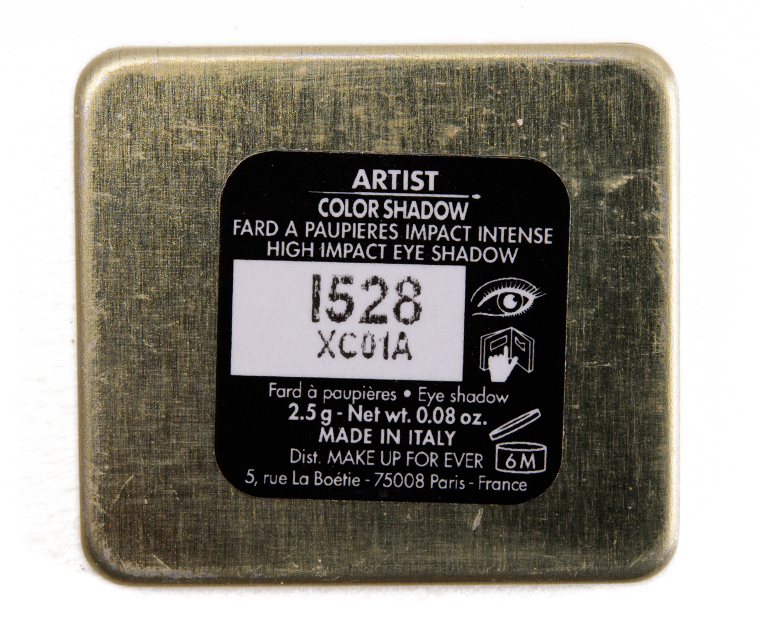







Thank you for reviewing this huge collection! I’m sad my favorite of the bunch X1918 doesn’t appear to be eye safe. I see you wore them though and didn’t appear to have any issues. That’s good to know.
No problem, Emily!
I didn’t – the biggest issue I’ve had (personally!) with eyeshadows that aren’t listed as eye safe (that to me appear due to dyes/pigments vs. chunky glitter – if it has glitter and isn’t listed as eye safe, then I won’t risk it) is staining.
I was hoping that the new version of 924, being matte, would be closer to #92 from the old, old line. Sadly, although it’s closer, it’s not very close at all.
I don’t know what’s keeping them from re-releasing this shade, it performed so well
Definitely not the same!
A really lovely range of purples here and I do like that Black Purple shade – very smokey.
A magnificent eye look Christine!
Thank you, Genevieve!
Black Purple has been on my list forever. I love it but I need to make a dent in my current shadow stash!
Good idea!!
I’m still sad they seem to have discontinued the old formula with next to no warning! This one just doesn’t seem to be quite as lovely, although it still looks good. Kind of a disappointment, I wish they had kept the old formula and just put it into this size pan.
Succinctly true!
I’m bummed that they didn’t do a clearance sale on them as individual shades (MUFE’s site did the X for $150 or something like that).
Right? I saw over Black Friday they did 12 for $75, but I had no idea that would be the end of it. I was so proud of myself for resisting temptation then, but if I had known that I couldn’t get them after, I would have totally stocked up!
I share your sentiments exactly, Kat! Why couldn’t MUFE just switched over to square pans instead of upending their entire eyeshadow line into something where the shades don’t even compare to their OG namesakes????
Right? I would have been thrilled if they’d taken that amazing, winner formula and put it into these smaller pans. Not sure why they messed with success there! If it was because they weren’t selling well, which I very much doubt, reducing the size and cost surely would have helped because whenever I talked to anyone about those shadows they said the only barrier to buying a ton was the size and cost. I had a whole wishlist of shades I was planning on buying over time to fill gaps in my collection.
Same.
Agreed!
I just am irked by this move of MUFE’s — they squandered their main asset: formulation quality. And, didn’t address customer requests like adding names to the numbers-only naming system, improve availability in-stores, shrink the pan quantity so it’s less daunting to customers. And also how they just stopped the line without any warning. It’s irritating.
Wow, what a stunning eye look! As soon as I saw the swatches in your gallery, I went out and grabbed the old Lavender, because the new color is so different.
Thank you, Katherine! 🙂
I was hoping for a re-release of the excellent old purple from MUFE, #92. They had something excellent yet they continue to release underperforming dupes of their own shade. I am happy to have gathered a lot of the good performing shades before they were discontinued
I must be the only one who wasn’t in love with the original #92, lol!
I’m sure there is a part of nostalgia behind the #92 🙂 But it’s a shade I reach for quite often, and I haven’t found another violet that stole my heart like this one
Christine, looking at the undersides and seeing those 2 different icons (not exactly a clear way to express that a product is or is NOT eye safe), I had to laugh at the 6 months after opening shelf life indicator. I’ve got shadows I’ve had for six YEARS and I still use them without any problems. But that symbol with the book and finger….what is that meant to convey? Is there some sort of manual we should be reading before using these???
I believe a lot of the more silicone-heavy formulations are listed as 6 months (IIRC, Anastasia’s palettes say 6 months!).
Sad about Purple not performing well, but I’m glad the other purple shades did. I like Blueberry the most and I don’t have a shade similar enough to it in my collection.
And… I meant Black Purple, not Blueberry.
Black Purple is a nice one!
Your eye look is gorgeous here. Purple is my favorite shadow color so I think I’ll be picking up a couple of these.
Towards the end of this MUFE journey, please consider writing a summary post of the finishes. Just something like, “the mattes are typically X and Y, with the lighter shades being more Z” that could be used as a reference when putting together palettes.
Beyond that, your eye look is gorgeous !
Hi Matthew,
There is one… just click “Formula Overview.” It’s listed with every single shade reviewed.
My goodness. Is there a color you don’t look beautiful in? Those purples look incredible on you!!! I have very light blue (and very sensitive) eyes. So, i try to steer clear of colors that are not “eye” safe. It is nice to see purples getting mostly high marks from you, as we all know that purple shades almost always get low to medium marks. Ultra Violet is the color of the year; so, I fully expect to see reviews of purples hitting the stores in the near furture.
Even though I am blown away by your gorgeous eye look, I am so let down by the changes in these shades from how they previously looked. Well, except for Orchid. That is the ONLY shade that appears to be improved. But what MUFE did to Blueberry, Black Purple, Pearl and Purple has me feeling very sad!
Gorgeous eye look!
Absolutely stunning eye look! Breathless